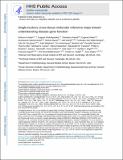Single-nucleus cross-tissue molecular reference maps toward understanding disease gene function
Author(s)
Eraslan, Gökcen; Drokhlyansky, Eugene; Anand, Shankara; Fiskin, Evgenij; Subramanian, Ayshwarya; Slyper, Michal; Wang, Jiali; Van Wittenberghe, Nicholas; Rouhana, John M; Waldman, Julia; Ashenberg, Orr; Lek, Monkol; Dionne, Danielle; Win, Thet Su; Cuoco, Michael S; Kuksenko, Olena; Tsankov, Alexander M; Branton, Philip A; Marshall, Jamie L; Greka, Anna; Getz, Gad; Segrè, Ayellet V; Aguet, François; Rozenblatt-Rosen, Orit; Ardlie, Kristin G; Regev, Aviv; ... Show more Show less
DownloadAccepted version (3.677Mb)
Open Access Policy
Open Access Policy
Creative Commons Attribution-Noncommercial-Share Alike
Terms of use
Metadata
Show full item recordAbstract
<jats:p>Understanding gene function and regulation in homeostasis and disease requires knowledge of the cellular and tissue contexts in which genes are expressed. Here, we applied four single-nucleus RNA sequencing methods to eight diverse, archived, frozen tissue types from 16 donors and 25 samples, generating a cross-tissue atlas of 209,126 nuclei profiles, which we integrated across tissues, donors, and laboratory methods with a conditional variational autoencoder. Using the resulting cross-tissue atlas, we highlight shared and tissue-specific features of tissue-resident cell populations; identify cell types that might contribute to neuromuscular, metabolic, and immune components of monogenic diseases and the biological processes involved in their pathology; and determine cell types and gene modules that might underlie disease mechanisms for complex traits analyzed by genome-wide association studies.</jats:p>
Date issued
2022Department
Massachusetts Institute of Technology. Department of BiologyJournal
Science
Publisher
American Association for the Advancement of Science (AAAS)
Citation
Eraslan, Gökcen, Drokhlyansky, Eugene, Anand, Shankara, Fiskin, Evgenij, Subramanian, Ayshwarya et al. 2022. "Single-nucleus cross-tissue molecular reference maps toward understanding disease gene function." Science, 376 (6594).
Version: Author's final manuscript